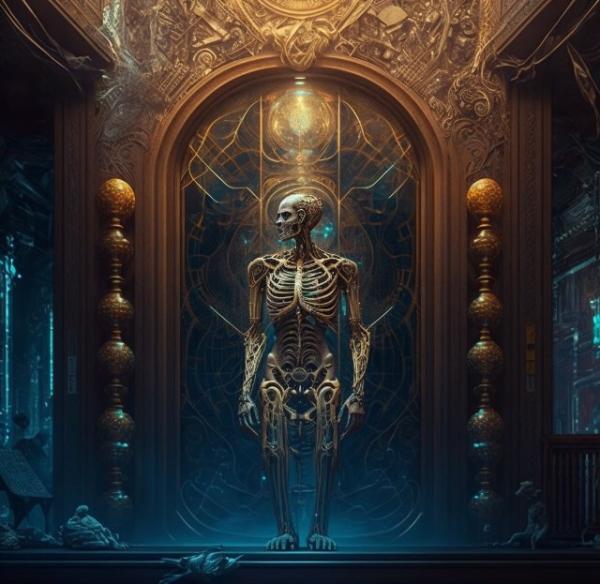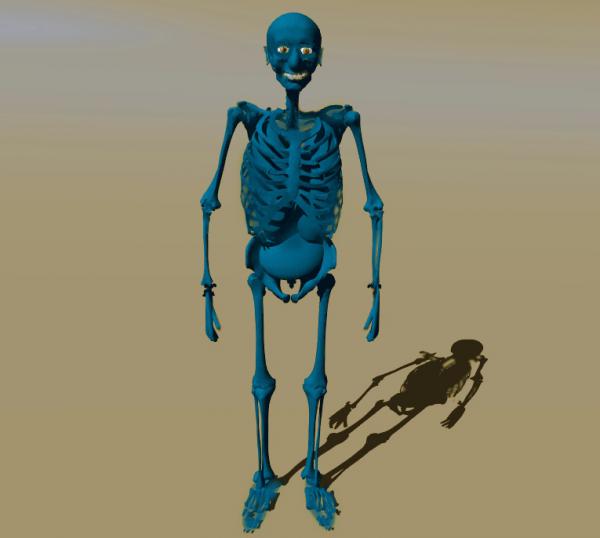BY LETTER
Skeletoids
Sophonts > Modosophonts > Biotech Cyborg (Bioborg)
Culture and Society > Cultures and Sub-Cultures > Cyborgs
Culture and Society > Cultures and Sub-Cultures > Cyborgs
Sophonts with minimal artificial muscle mass, giving an emaciated, 'skeletal' appearance |
 Image from Keith Wigdor and Midjourney Ai |
Many cyborgs, vecs and related phyles use artificial muscle fibres to move their limbs and to otherwise modify their physical configuration. Several different artificial muscle fibres are available for this purpose, many of which are considerably stronger than biological muscle; the extreme example of this is Ultimate Muscle, which has a maximum strength approximately 10e5 times that of biological muscle, but there are numerous other muscle fibre types which have strengths somewhere between the two.
A humanoid cyborg or bioborg which uses one of these muscle fibre types can be considerably stronger than a biological human, even if they only use a small amount of artificial muscle. The artificial muscle fibres may sometimes be imbedded in a mass of biological muscle or even inert tissue, especially if the user wishes to conform to certain human physical standards. Many cyborg or bioborg body plans resemble nearbaseline humans so closely as to be indistinguishable without an internal scan.
However a number of cyborgs and bioborgs prefer a more mimimalist option. Using only narrow, string-like fibres of suitable artificial muscle, a humanoid skeletoid can still be as physically strong as a near-baseline human. By increasing the thickness of these strings only slightly the user can be significantly stronger. The combination of thin, chord-like muscles and a humanoid bodyplan gives a skeleton-like appearance to sophonts of this type; this effect is often enhanced by a thin layer of translucent skin which reveals structures that might otherwise be hidden.
Several different clades have adopted this bodytype over the history of the Terragen Sphere, including true cyborgs who retain many human features but have artificially constructed muscles and strengthened bones, bioborgs who grow the fibres within their bodies biologically, and synthetic humans who consist completely of artificial materials. This bodytype does inspire a certain amount of distaste, fear or even revulsion in certain nearbaseline cultures, but it is accepted in many others as a valid and even aesthetically interesting choice.
 Image from Steve Bowers |
Body expansion technology
A significant fraction of sophonts which have adopted the skeletoid bodymorph possess the ability to 'fill in' the surface of their bodies, in order to mimic a more conventional humanoid appearance. By selectively inflating the artificial skin that covers their bones using ambient or stored fluids, they can mimic human flesh and even hairstyles. An 'inflated' skeletoid can adopt a wide range of facial characteristics, and take on the appearance of any particular person, real or fictional. This process can be reversed quite simply and the sophonts can return to their skeletal state. In general an 'inflated' skeletoid morph will be very lightweight, so the morph might utilise some inert substance (such as sand, or water) to increase its body mass and stability.Another capability which is becoming increasingly popular among sophonts who have adopted a skeletoid morph is telescopic bones; these can change shape and extend or contract in order to change the dimensions and disposition of the skeleton. Coupled with body expansion technology, telescopic bone systems can allow a sophont to rapidly change shape and adopt a wide range of animal or non-humanoid bodymorphs at will.
Related Articles
Appears in Topics
Development Notes
Text by Steve Bowers
Initially published on 21 May 2015.
Initially published on 21 May 2015.






